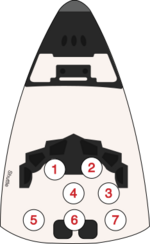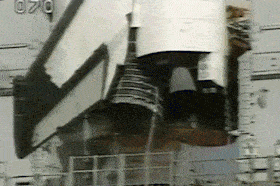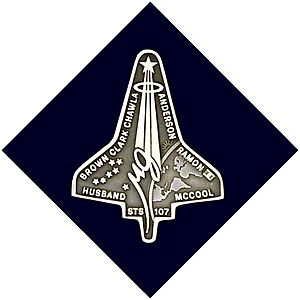STS-107 facts for kids

Spacehab's Research Double Module in Columbia's payload bay during STS-107
|
|
| Names | Space Transportation System-107 |
|---|---|
| Mission type | Microgravity research |
| Operator | NASA |
| Mission duration | 15 days, 22 hours, 20 minutes, 32 seconds |
| Distance travelled | 6,600,000 miles (10,600,000 km) |
| Orbits completed | 255 |
| Spacecraft properties | |
| Spacecraft | Space Shuttle Columbia |
| Launch mass | 263,706 pounds (119,615 kg) |
| Landing mass | 232,793 pounds (105,593 kg) (expected) |
| Payload mass | 32,084 pounds (14,553 kg) |
| Crew | |
| Crew size | 7 |
| Members | |
| Start of mission | |
| Launch date | January 16, 2003 15:39:00 UTC |
| Launch site | Kennedy, LC-39A |
| End of mission | |
| Decay date | February 1, 2003, 13:59:32 UTC Disintegrated during reentry |
| Landing site | Kennedy, SLF Runway 33 (planned) |
| Orbital parameters | |
| Reference system | Geocentric |
| Regime | Low Earth |
| Perigee | 170 miles (270 km) |
| Apogee | 177 miles (285 km) |
| Inclination | 39.0 degrees |
| Period | 90.1 minutes |
 STS-107 mission patch 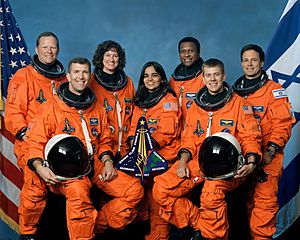 Rear (L-R): David Brown, Laurel Clark, Michael Anderson, Ilan Ramon; Front (L-R): Rick Husband, Kalpana Chawla, William McCool |
|
STS-107 was the 113th flight of the Space Shuttle program. It was also the 28th and final flight of Space Shuttle Columbia. The mission ended tragically on February 1, 2003. During its return to Earth, the Space Shuttle Columbia broke apart, killing all seven astronauts on board. This event is known as the Space Shuttle Columbia disaster.
The flight began on January 16, 2003, launching from the Kennedy Space Center in Florida. The shuttle spent nearly 16 days in orbit, where the crew performed many international science experiments. The disaster happened as the shuttle was re-entering Earth's atmosphere over Texas.
After the accident, NASA formed the Columbia Accident Investigation Board. They wanted to find out why the shuttle broke apart. They discovered that a piece of foam had fallen off the shuttle during launch. This foam hit and damaged the shuttle's heat shield on the left wing. This heat shield is made of special materials like reinforced carbon-carbon panels and thermal protection tiles. During re-entry, the damaged wing got very hot and started to break apart. This caused the shuttle to lose control and disintegrate. Today, a part of the cockpit window frame is on display at the Kennedy Space Center, honoring the crew.
Contents
Meet the Crew
Seven brave astronauts were part of the STS-107 mission. They worked in two teams, called "red" and "blue," to conduct experiments around the clock.
| Position | Astronaut | |
|---|---|---|
| Commander | Second and last spaceflight |
|
| Pilot | Only spaceflight |
|
| Mission Specialist 1 | Only spaceflight |
|
| Mission Specialist 2 Flight Engineer |
Second and last spaceflight |
|
| Mission Specialist 3 | Second and last spaceflight |
|
| Mission Specialist 4 | Only spaceflight |
|
| Payload Specialist 1 | Only spaceflight |
|
Where the Crew Sat
The astronauts had specific seats for launch and landing. Seats 1-4 were on the Flight Deck, which is like the cockpit. Seats 5-7 were on the Middeck, a lower area.
Mission Experiments and Discoveries
STS-107 carried a special laboratory called the SPACEHAB Research Double Module (RDM). This was its first flight. The shuttle also carried the Freestar experiment and an Extended Duration Orbiter pallet.
One interesting discovery during the mission involved a video taken to study atmospheric dust. It might have shown a new atmospheric event, which scientists called a "TIGER." This stands for Transient Ionospheric Glow Emission in Red.
A very special item on board Columbia was a copy of a drawing by Petr Ginz. Petr was a 14-year-old prisoner during World War II. He drew what he imagined Earth looked like from the Moon. This copy was carried by astronaut Ilan Ramon and was sadly lost in the disaster. Ramon also carried a dollar bill given to him by a famous religious leader.
Students from Australia also had an experiment on board. They wanted to see how zero gravity affected the web-building of the Australian garden orb weaver spider.
Types of Experiments Carried
The mission included many different experiments. Here are some examples:
- In SPACEHAB RDM:
- 9 commercial experiments and 21 investigations.
- 4 experiments for the European Space Agency with 14 investigations.
- 1 experiment for reducing risks on the International Space Station.
- 18 experiments for NASA's Office of Biological and Physical Research.
- In the payload bay (attached to RDM):
- Combined Two-Phase Loop Experiment (COM2PLEX).
- Miniature Satellite Threat Reporting System (MSTRS).
- Star Navigation (STARNAV).
- FREESTAR experiments:
- Critical Viscosity of Xenon-2 (CVX-2).
- Space Experiment Module (SEM-14).
- Mediterranean Israeli Dust Experiment (MEIDEX).
- Low Power Transceiver (LPT).
- Solar Constant Experiment-3 (SOLCON-3).
- Shuttle Ozone Limb Sounding Experiment (SOLSE-2).
- Other experiments:
- Shuttle Ionospheric Modification with Pulsed Local Exhaust Experiment (SIMPLEX).
- Ram Burn Observation (RAMBO).
Even though Columbia was lost, a lot of the mission's science data was saved. About 30% of the data was sent back to Earth during the flight. Another 5-10% was recovered from samples and hard drives found after the disaster. This means scientists still got about 35-40% of the total data.
Some experiments were found mostly intact in the debris field. For example, 99% of the data for the Critical Viscosity of Xenon-2 (CVX-2) experiment was recovered. This happened because the equipment and hard drive were found, even though they were damaged. Many student experiments involving crystal-forming were also found completely intact. Amazingly, samples of moss and roundworms from other experiments survived the crash. These findings have helped scientists learn more about how tiny living things might survive long journeys in space.
The Re-entry Accident
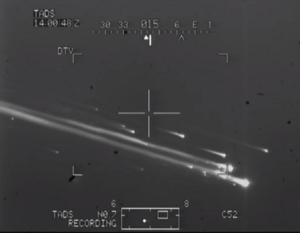
Columbia began its return to Earth as planned. However, the heat shield on its left wing had been damaged during launch. This damage allowed extremely hot gases from re-entry to get inside the wing. The heat slowly spread, causing the wing to overheat and break apart. This led to the shuttle losing control and disintegrating. The accident happened about 16 minutes before the shuttle was supposed to land.
After the accident, a 7-month investigation began. Teams searched for debris, collecting over 85,000 pieces of the shuttle. This was about 38% of the entire vehicle.
Mission Patch (Insignia)
The mission patch for STS-107 is special because it's shaped like the Space Shuttle itself. In the middle of the patch, you can see the symbol for microgravity (μg). This symbol flows into the rays of an astronaut symbol.
The angle of the astronaut symbol, 39 degrees, shows the mission's orbital inclination (how tilted its orbit was compared to the Earth's equator). The sunrise on the patch represents new beginnings for space research. The Earth and stars show the wide range of science and space exploration done on the mission.
The constellation Columba, which means "the dove", was chosen to represent peace and the Space Shuttle Columbia. The seven stars on the patch stand for the seven crew members. One star has six points, like a Star of David, to honor Israel's contributions to the mission. Astronaut Ilan Ramon was the first Israeli in space. The patch design was mainly created by crew members Dr. Laurel Clark and Dr. Kalpana Chawla.
Wake-Up Calls
A tradition in space missions is to wake up astronauts each morning with music. This music is chosen by their families, friends, or Mission Control. On STS-107, even though the crew worked in two shifts, each shift still received a "wake-up call."
| Flight Day | Team | Song | Artist/Performer | Played for | Link |
|---|---|---|---|---|---|
| Day 2 | Blue Team Red Team |
"EMA EMA" "America, the Beautiful" |
Not listed Texas Elementary Honors Choir |
Dave Brown Rick Husband |
WAV WAV |
| Day 3 | Blue Team Red Team |
"Coming Back to Life" "Space Truckin' |
Pink Floyd Deep Purple |
Willie McCool Kalpana Chawla |
WAV WAV |
| Day 4 | Blue Team Red Team |
"Cultural Exchange" "Hatishma Koli" |
Not listed The High Windows |
Dave Brown Ilan Ramon |
WAV WAV |
| Day 5 | Blue Team Red Team |
"Fake Plastic Trees" "Amazing Grace" |
Radiohead Black Watch and 51st Highland Brigade Band |
Willie McCool Laurel Clark |
WAV WAV |
| Day 6 | Blue Team Red Team |
"Texan 60" "God of Wonders" |
Not listed Steve Green |
Dave Brown Rick Husband |
WAV WAV |
| Day 7 | Blue Team Red Team |
"The Wedding Song" "Prabhati" |
Paul Stookey Ravi Shankar |
Willie McCool Kalpana Chawla |
WAV WAV |
| Day 8 | Blue Team Red Team |
"Hakuna Matata" "Ma ata osheh kesheata kam baboker?" |
The Baha Men Arik Einstein |
Michael Anderson Ilan Ramon |
WAV WAV |
| Day 9 | Blue Team Red Team |
"Burning Down The House" "Kung Fu Fighting" |
Talking Heads Carl Douglas |
To honor combustion experiments Whole crew |
WAV WAV |
| Day 10 | Blue Team Red Team |
"Hotel California" "The Prayer" |
The Eagles / McCool Family Celine Dion |
Willie McCool Rick Husband |
WAV WAV |
| Day 11 | Blue Team Red Team |
"I Say a Little Prayer" "Drops of Jupiter" |
Dionne Warwick Train |
Michael Anderson Kalpana Chawla |
WAV WAV |
| Day 12 | Blue Team Red Team |
"When Day is Done" "Love of My Life" |
Django Reinhardt and Stephane Grappelli Queen |
Dave Brown Ilan Ramon |
WAV WAV |
| Day 13 | Blue Team Red Team |
"Slow Boat to Rio" "Running to the Light" |
Earl Klugh Runrig |
Mike Anderson Laurel Clark |
WAV WAV |
| Day 14 | Blue Team Red Team |
"I Get Around" "Up On the Roof" |
The Beach Boys James Taylor |
Dave Brown Rick Husband |
WAV WAV |
| Day 15 | Blue Team Red Team |
"Imagine" "Yaar ko hamne ja ba ja dekha" |
John Lennon Abita Parveen |
Willie McCool Kalpana Chawla |
WAV WAV |
| Day 16 | Blue Team Red Team |
"Silver Inches" "Shalom lach eretz nehederet" |
Enya Yehoram Gaon |
Dave Brown Ilan Ramon |
WAV WAV |
| Day 17 | Blue Team Red Team |
"If You've Been Delivered" "Scotland the Brave" |
Kirk Franklin The Black Watch and 51st Highland Brigade Band |
Michael Anderson Laurel Clark |
WAV WAV |
Images for kids
-
A view of Mount Fuji and the surrounding area from Columbia
See also
 In Spanish: STS-107 para niños
In Spanish: STS-107 para niños
- List of Space Shuttle missions
- Outline of space science


